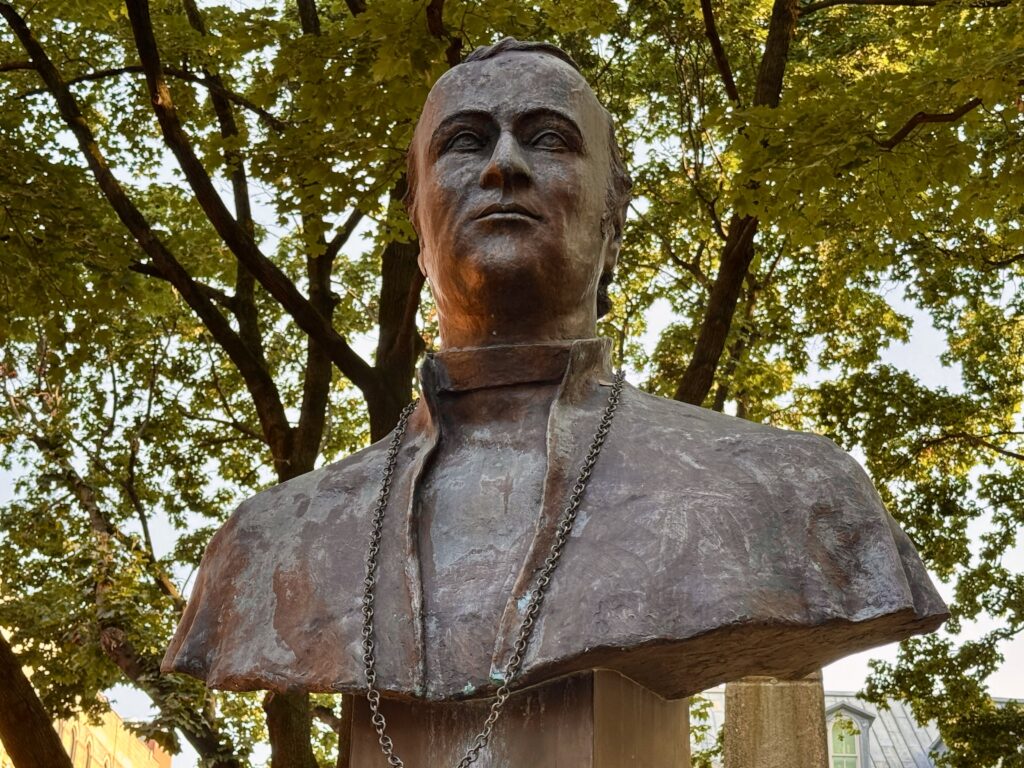
The Archdiocese of New York at 175: The Role of Religious Communities
By: The Good Newsroom
John Hughes was especially fond of the Sisters of Mercy, whom he invited to the diocese on a trip to Dublin

On July 19, 1850, Pope Pius IX established the Archdiocese of New York, a significant development in the city and the area’s Catholic history. The archdiocese’s first archbishop was the colorful and controversial John Hughes.
In 2000, the late historian Monsignor Thomas J. Shelley commemorated the 150th anniversary of the archdiocese for Catholic New York, highlighting the times, New York City’s immigrant population, and the first Archbishop of New York who made it the most important archdiocese in the country. The Good Newsroom is pleased to celebrate the 175th anniversary of the archdiocese by serializing that history throughout the week of July 14-18. The text has been updated slightly to reflect the passage of time.
New York’s first religious community, the Sisters of Charity, became embroiled in a dispute with Hughes that led to a split in the community in 1846. Of the 62 sisters in New York, 29 returned to Emmitsburg while the other 33 sisters formed their diocesan community, the Sisters of Charity of St. Vincent de Paul. Their first superior, Mother Elizabeth Boyle, like St. Elizabeth Ann Seton herself, was a convert to Catholicism. The Sisters of Charity grew rapidly in the late 19th century and became the largest community of women religious in the archdiocese. They numbered 930 by 1885 and provided an army of teachers for the parochial schools. During the cholera epidemic of 1849, they established New York’s first Catholic hospital, St. Vincent’s Hospital, under the direction of Sister Angela Hughes, the archbishop’s sister. They also staffed the girls’ division of the Catholic Protectory, a large child-caring institution established by John Hughes in 1863. Shortly after Hughes’ death, Sister Irene Fitzgibbon founded one of New York City’s most famous charitable institutions, the New York Foundling Hospital. At Sister Irene’s death in 1896, The New York Times called her “the most remarkable woman of her age in her field of philanthropy.”
John Hughes was especially fond of the Sisters of Mercy, whom he invited to the diocese on a trip to Dublin. The first seven sisters arrived in New York in 1846. As was their custom in the major port cities of the United States, three years later, they opened a House of Mercy on Houston Street, which was both a residence and a vocational school for single immigrant girls. The House of Mercy proved so successful that it placed 8,000 girls in jobs during its first five years of operation. Other Sisters of Mercy volunteered as nurses in military hospitals during the Civil War and served as unofficial chaplains at the notorious Tombs Prison.
The Religious of the Sacred Heart came to the diocese in 1841 and opened an academy for “young ladies of the higher class.” Tuition was a steep $250 per year, an indication of a developing Catholic middle class with social aspirations for its daughters. The sisters also used the tuition from their academy to operate a free school for the poor. The other new women religious were the Ursulines who began an academy in Morrisania in 1855; the School Sisters of Notre Dame who came from Germany in 1857 to staff the parochial school of Most Holy Redeemer parish and to open a German orphan asylum in Yorkville; and the Sisters of the Good Shepherd, who established a home for delinquent girls on East 14th Street in 1857.
The first male religious community to make a permanent foundation in New York was the Redemptorists in 1842. Hughes was happy to have them for two reasons. They staffed several of the big German parishes, and they also specialized in conducting parish missions in both German and English. These parish missions were the Catholic equivalent of Protestant revivals, and the Redemptorists’ preaching was very much of the fire-and-brimstone variety. One of them gave such a vivid description of hell from the pulpit one summer day when the windows of the church were open that firemen from a nearby firehouse rushed to the church to put out the blaze.
The Fathers of Mercy, a small French community, arrived in 1842 to take charge of St. Vincent de Paul Church. A few years later, the first Brothers of the Christian Schools also came from France. They provided teachers for the boys in many of the parochial schools, staffed the boys division of the Catholic Protectory, and started an academy that developed into Manhattan College. Hughes also tried to bring the Dominican Friars to New York, but their Master General politely but firmly declined the invitation. Three years after Hughes’ death, however, they arrived in New York to establish St. Vincent Ferrer Church at Lexington Avenue and 66th Street. By that time, both the Order of Friars Minor and the Capuchin Friars were also at work in the archdiocese, at St. Francis of Assisi Church on West 31st Street and St. John’s Church on West 30th Street, respectively.
In 1858, Archbishop Hughes also welcomed Father Isaac Hecker to the archdiocese, where he established the headquarters of his new Missionary Society of St. Paul (Paulist Fathers), the first religious community of men founded in the United States. Like Hecker himself, the other original members of this community were all converts, who devoted their energies to explaining the Catholic Church to America and America to the Catholic Church. At their Church of St. Paul the Apostle on West 59th Street, they also established a model parish that was noted for the quality of its liturgy, music, lectures, and catechetical programs.
John Hughes was also happy to have the Jesuits back in New York. They had been here twice before, briefly in the 1680s under colonial Gov. Thomas Dongan, and again from 1808 to 1815, when they ran the infant Diocese of New York under the capable leadership of Father Anthony Kohlmann. The “Third Coming” of the Society of Jesus to New York occurred in 1846 when Hughes invited a group of exiled French Jesuits in Kentucky to take charge of his new college and seminary at Fordham. He also assigned them the parish of St. Francis Xavier in Manhattan.
Hughes was as much interested in Catholic higher education as he was in parochial schools. In 1839, he bought 100 acres of Fordham Manor, and there he founded St. Joseph’s Seminary in 1840 and St. John’s College the following year. “I had not, when I purchased the site,” he admitted, “so much as a penny wherewith to commence the payment for it.” Although Bishop Hughes was desperate for more diocesan priests, he was also concerned about the caliber of the New York presbyterate. “Clergymen, some of doubtful character and some of whom there is no doubt have found easy admission into the diocese,” he complained, “and religion suffers in consequence.” Both the seminary and the college were operated by the diocesan clergy until Hughes handed them over to the Society of Jesus in 1846. The Jesuits continued to operate the seminary until 1855, when they withdrew after a series of disputes with Hughes. New York’s first St. Joseph’s Seminary lasted another five years under diocesan management, but Hughes was forced to close it in 1860 due to a lack of money and faculty. “The pride of my early episcopacy,” he called it wistfully.
St. John’s College had a happier fate and developed into Fordham University. The Jesuits established a second college in New York in 1850, the College of St. Francis Xavier, a commuter college on West 16th Street. Tuition at St. John’s College was $200 per year, while at St. Francis Xavier, it was only $60 per year, making it more accessible to the Catholic lower middle class. During its brief 61-year history (it merged with Fordham in 1911), the College of St. Francis Xavier provided both the Society of Jesus and the archdiocese with numerous vocations. It also educated a whole corps of successful businessmen, teachers, doctors, and lawyers, who formed the Catholic lay elite in New York. Membership in the Xavier Union, the university’s alumni association, was so coveted that it was transformed into the prestigious Catholic Club of New York, which boasted a stately clubhouse on Central Park South.

